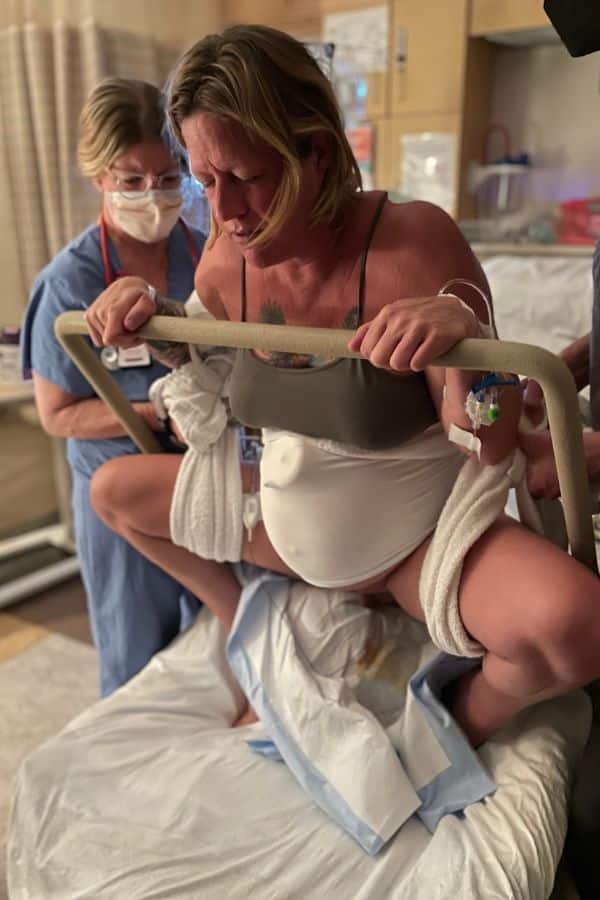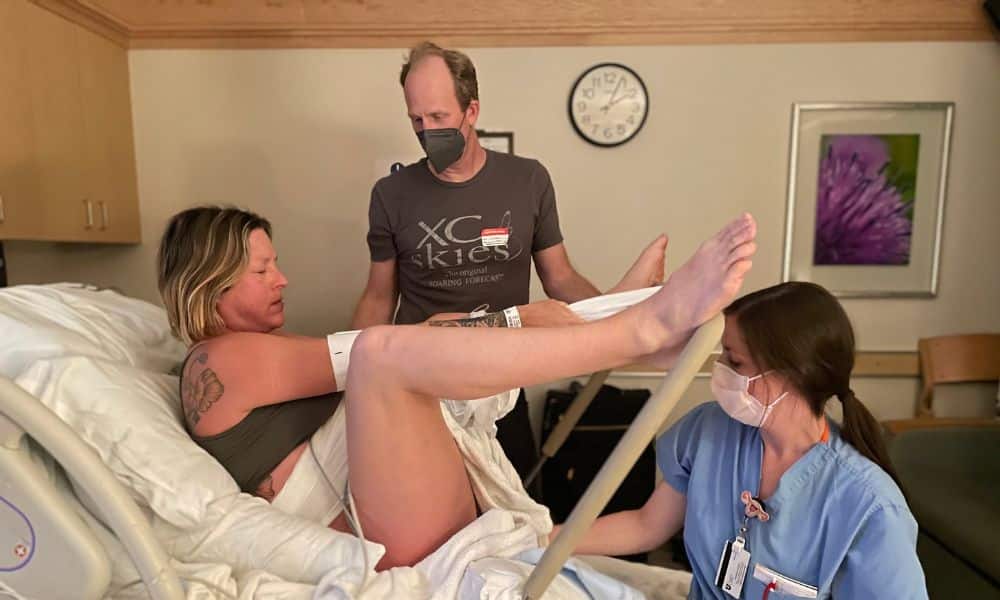
How, when and why to use a squat bar in labor
Did you know that every hospital labor + delivery unit has a labor squat bar that you can use? Attached to your hospital bed, it can be a great tool to support your pushing stage in labor and birth. Our birth doulas love using the squat bar during the 2nd stage of labor.
What is a labor squat bar?
A labor squat bar, also called a "birthing bar," is a metal bar that clicks into a hospital bed. It can be helpful for a wide range of positions during labor and pushing. Even if you're not someone who can normally squat with ease, the bar helps you feel confident in this position. You can pull and push on the bar as much as you want - it is designed to give the support you need.
If you look around your hospital room, you may see it in a corner, or it may be hidden away. You will just have to ask your nurse for it, and they will get it set up for you. As a bonus, your nurse can also drop the foot of your bed and raise the back. Your hospital bed can adjust in lots of very useful ways to support your use of the squat bar. That way, you can rest against the bed between contractions and pull yourself back up when the next one comes.
Positions supported by a squat bar during the second stage of labor
As your body works through the second stage of labor, a squat bar can become a valuable ally. The benefits of being upright in labor and birth are well documented. Using a labor squat bar supports positions that maximize comfort, optimize gravity, and encourage efficient progress. When using a squat bar, extra pillows and support are helpful to move between pushing & rest positions. Here are some positions where a squat bar may prove especially helpful:
Upright Squat Position
One way is to hold onto it while you…you guessed it…squat during pushing. The upright squat position helps to engage your pelvic muscles effectively and use gravity to aid in your baby’s descent. With the bar providing stability, this position also reduces strain on your legs and can help open the pelvis wider. For some people, a squatting position can be just what they need to move their baby down into the pelvis.
Supported Kneeling Position
By kneeling on the bed while holding the bar, you can create more space in your pelvis. Plus, this position relieves pressure on your lower back, offering a balance of comfort and functionality.
Angled Sitting Position
The squat bar also supports an angled or semi-reclined sitting position. With your back against the bed and your hands gripping the bar, you can stay upright without getting tired. You can conserve your energy AND keep your pelvis wide open!
Side lying with a squat bar
For this pushing position, lower the head of the bed so you’re lying on your side, and put a few pillows under your head for comfort. You can put one foot up on the side or top of the squat bar during pushing to brace against, allowing you to focus all your energy and power down into your pelvic floor.
Tug of War with a Squat Bar
The "tug of war" position is a favorite of our doulas. Simply tie a flat bed sheet or a non-stretch scarf to the labor squat bar for a “tug-of-war” position. This allows you to focus all your energy down into your pelvis to push your baby out.
Each position offers unique benefits, so explore what feels right for your body. The squat bar’s versatility ensures you can find strength and balance during this pivotal stage of your labor and birth.
The images below show a birthing person with an epidural using the squat bar to push during contractions. When the contraction is over, she rests back on the bed in a seated position. The foot of the bed has been lowered so she can sit comfortably with the feet below the knees.
Notice how the nurse and partner are supporting the legs with a towel wrapped around the thigh. Since she had an epidural, this extra leg support was essential in allowing the birthing parent to get into a squatting position.


5 Tips for using the squat bar in labor
Use support
Squatting is hard work, and support helps, even with a squat bar. Place your birth ball behind you on the bed to lean back into when you need it.
Switch it up
You don’t have to use the squat bar the whole time. Use the bar for a few contractions, then rest in another position. Movement helps labor progress, but breaks matter too.
Keep your feet flat
If you can, plant your heels so your weight is evenly spread. This gives you better stability and helps your pelvis open more effectively.
Listen to your body
You don’t have to love the squat bar. If it's not working for you, move on! The squat bar is just one tool. Use what works, skip what doesn’t.
Adjust the height
Don’t settle for awkward. Ask your nurse to help you adjust the foot of the bed and the height of the bed (these can be both raised and lowered) to a position that allows you to use the squat bar comfortably without straining your knees or hips. You can even position yourself sitting upright and leaning forward onto the squat bar with a pillow on it, similar to the toilet and pillow labor position we shared with you in our blog post on laboring in the bathroom!
Stay hydrated
Labor is a workout. Sips of water or electrolyte drinks between contractions can help keep your energy up - especially if you're doing active positions like squatting.
Can I use a squat bar if I have an epidural?
This will depend on a few factors:
How strong is your epidural, and how is your body metabolizing the medicine? Some birthing people find they’re still able to have quite a bit of mobility in their legs with an epidural. Others can’t move their lower half at all without a lot of help from their partner, doula, or nurse. You can’t really know how your body will respond to the epidural until you get it. You will have to see how it feels in the moment.
Do you have supportive providers and hospital staff? If your OB, midwife, or nurse is not supportive or encouraging of you trying different pushing positions with an epidural, it will be really hard, or even impossible, to use a labor squat bar.
This is a great topic to bring up at your prenatal visits with your provider before your birth. A great question to ask is, “What positions are you comfortable with me pushing in if I have an epidural?” Or, “I’d like to try the squat bar during labor. Are there certain circumstances that would prevent me from doing that, in your opinion?”
Do you have hands-on support in the hospital room with you? A doula or supportive partner is very helpful in making the use of a squat bar a reality. Most birthing people need help to get into a squat position, even with the bar.
While your nurse may be able to help with your positioning during pushing, their main focus is always on the health and safety of you and your baby. So if something else takes precedence, they may not have the availability to be as hands-on with you.
This is where having a doula and/or supportive partner can be really helpful. As a continuous presence in your hospital room, they can be the extra pair of hands you need to maneuver into different pushing positions with an epidural in place.

Using a squat bar with an epidural. This birthing person is doing the “tug-of-war” with a flat hospital sheet that is wrapped around the squat bar.
Is there any time when I shouldn’t use a squat bar in labor?
Having a supportive care provider is imperative to being able to use a squat bar during pushing. If your provider is not open to you using a labor squat bar for any reason, then it is worth asking more questions. Explore their concerns, and possibly defer to their decision not to use the squat bar if you feel like it makes sense for you.
Also, if you try the squat bar and find it painful or uncomfortable, stop using it. There are plenty of positions to choose from that will feel better. You might be able to try the squat bar again later, or it may not be the right tool for your unique body and needs.
Finally, do not use the squat bar if the position causes your baby distress (such as heart rate decelerations or other signs of stress). The hospital staff will help you find a different position that your baby tolerates better.
I hope this blog post helps you better understand what a labor squat bar is, and how and when to use it.
Are you in the Salt Lake City area and want to explore having skilled support for your hospital birth? We're here to help you to learn more about our birth doula services and book your free consult.

Heart Tones Birth Services is an award-winning birth + postpartum doula agency in Salt Lake City, Utah. We provide expert, reliable, unbiased care and support as you embark on the wild and beautiful ride of parenthood. Contact us today to explore your support options.
